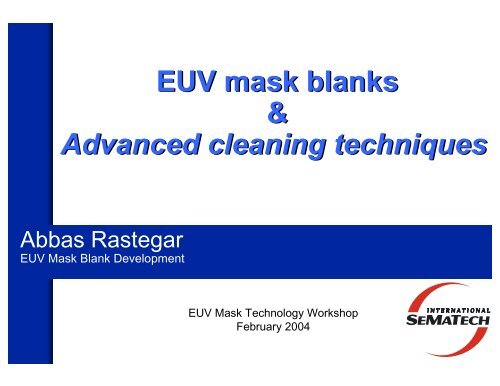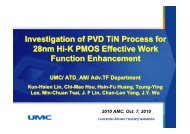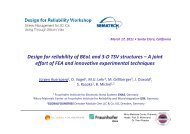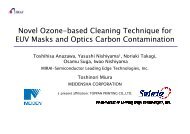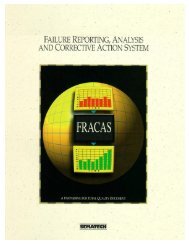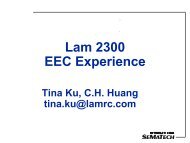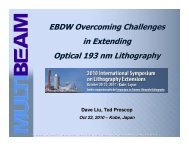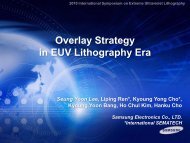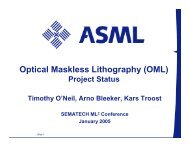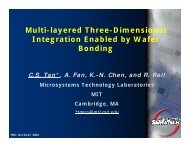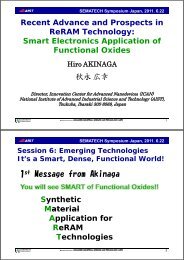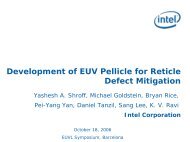Mask Cleaning Mechanisms and Techniques - Sematech
Mask Cleaning Mechanisms and Techniques - Sematech
Mask Cleaning Mechanisms and Techniques - Sematech
Create successful ePaper yourself
Turn your PDF publications into a flip-book with our unique Google optimized e-Paper software.
EUV mask blanks<br />
&<br />
Advanced cleaning techniques<br />
Abbas Rastegar<br />
EUV <strong>Mask</strong> Blank Development<br />
EUV <strong>Mask</strong> Technology Workshop<br />
February 2004
Outline<br />
• EUV mask blanks<br />
• <strong>Cleaning</strong> requirements of EUV mask substrates<br />
• Current quality of EUV mask substrates <strong>and</strong> defects<br />
• Particle adhesion mechanism in liquids<br />
• Advanced mask cleaning techniques<br />
• Conclusion<br />
A. Rastegar International SeMaTech<br />
2
EUV <strong>Mask</strong> Terminology<br />
• EUV Bulk Material: Initial bulk Low Thermal Expansion Material (LTEM)<br />
having intrinsic properties of CTE, homogeneity, stiffness, etc.<br />
• EUV Substrate: The finished 152mm x 152mm x 6.32mm (6” x 6” x 0.25”)<br />
LTEM before any reflective or absorber films are deposited<br />
• EUV <strong>Mask</strong> Blank: The finished 152mm x 152mm x 6.32mm (6” x 6” x 0.25”)<br />
blank with all reflective, buffer, absorber films completed<br />
• EUV <strong>Mask</strong>: Completed patterned reticle that is scanned exp. system<br />
A. Rastegar International SeMaTech<br />
3
EUV <strong>Mask</strong>s<br />
‰ Thermally stable substrate materials (LTEM;<br />
ULE ® , Zerodur ® )<br />
‰ Surface planarity (flatness) < 50nm peak to<br />
valley<br />
‰ Multilayer reflector is similar to optics<br />
elements, but<br />
‰ Requires zero defects in or on multilayer<br />
‰ Buffer <strong>and</strong> absorber layer are etched to<br />
create the mask pattern<br />
‰ No pellicle<br />
‰ <strong>Mask</strong> requires ultra clean storage <strong>and</strong><br />
h<strong>and</strong>ling<br />
Patterned EUV mask<br />
Absorber<br />
Patterned Absorbers<br />
~ 100 nm thick<br />
(e.g. Al, Cr, TaN, W)<br />
Buffer Layer<br />
~ 50 nm thick<br />
(e.g. SiO 2 )<br />
Reflective Multilayers<br />
~ 300 nm thick<br />
(Mo - Si = 13.5nm)<br />
40 - 50 Pairs<br />
φ 1<br />
6<br />
o<br />
LTEM Sub.<br />
Low thermal expansion substrate<br />
Buffer<br />
Multilayer<br />
Low thermal expansion<br />
substrate<br />
<strong>Mask</strong> cross section<br />
A. Rastegar International SeMaTech<br />
4
EUV Substrate specifications<br />
6.35 ± 0.1 mm<br />
152.0 ± 0.1 mm<br />
142 mm<br />
Backside flatness quality area:<br />
(500 nm)<br />
50 nm P-V flatness<br />
HSFR 1 µm<br />
Critical<br />
142 mm<br />
Defect quality area:<br />
0 defects >50 nm PSL<br />
equivalent<br />
Edge region flatness:<br />
152 mm<br />
HSFR λ spatial > 400 nm<br />
Substrate material:<br />
CTE < 30 ppb/ ºK at 22±3ºC<br />
Critical<br />
Critical<br />
A. Rastegar International SeMaTech<br />
5
<strong>Cleaning</strong> aspects of EUV lithography<br />
Conventional Photolithography<br />
EUV lithography<br />
UV<br />
EUV<br />
•Transmission<br />
•Pellicle<br />
•Reflection<br />
• NO Pellicle<br />
<strong>Mask</strong> cleaning in fab is required<br />
A. Rastegar International SeMaTech
Outline<br />
• EUV mask blanks<br />
• <strong>Cleaning</strong> requirements of EUV mask substrates<br />
• Current quality of EUV mask substrates <strong>and</strong> defects<br />
• Particle adhesion mechanism in liquids<br />
• Advanced mask cleaning techniques<br />
• Conclusion<br />
A. Rastegar International SeMaTech<br />
7
EUV <strong>Mask</strong> Blank Development Center<br />
Development substrates<br />
Super polished quartz substrate with Cr in the back<br />
side<br />
Proposed process flow<br />
Substrate clean Æ defect inspectionÆ ML deposition<br />
ÆML clean Æ defect inspection<br />
A. Rastegar International SeMaTech<br />
8
<strong>Cleaning</strong> requirements<br />
ITRS Roadmap: Defect density = 0.003 @ 32nm<br />
We have to develop cleaning processes that are capable<br />
of cleaning sub-100 nm particle on non-patterned<br />
1. quartz surface with Chromium back side<br />
2. Si cap layer on top of MoSi ML film on quartz substrate<br />
with Chromium back side<br />
Surface roughness: No measurable change G =0<br />
Surface flatness: No measurable change G’ =0<br />
*This presentation only discuss quartz surface <strong>and</strong> MoSi Ml will be presented separately<br />
A. Rastegar International SeMaTech<br />
9
Outline<br />
• EUV mask blanks<br />
• <strong>Cleaning</strong> requirements of EUV mask substrates<br />
• Current quality of EUV mask substrates <strong>and</strong> defects<br />
• Particle adhesion mechanism in liquids<br />
• Advanced mask cleaning techniques<br />
• Conclusion<br />
A. Rastegar International SeMaTech<br />
10
Quartz substrate<br />
Typical roughness:(1.5-1.9 nm RMS )<br />
A. Rastegar International SeMaTech<br />
11
Natural defects: maps<br />
Natural defects: any defect that is detected by our inspection tool when we get them from suppliers<br />
Sample1-Cr backside<br />
Sample 2-Cr backside<br />
Sample 3- No Cr<br />
A. Rastegar International SeMaTech<br />
12
Natural defects: size distribution<br />
400<br />
350<br />
300<br />
Inspection capability<br />
Sample 1<br />
Sample 2<br />
250<br />
Defect counts<br />
200<br />
150<br />
100<br />
50<br />
0<br />
-50<br />
Source: A. Rastegar<br />
0 50 100 150 200 250 300 350<br />
defect size (nm)<br />
A. Rastegar International SeMaTech<br />
13
Natural defect: removability<br />
A. Rastegar International SeMaTech<br />
14
Natural defect: Compositions<br />
Mostly Carbon, SiO2, <strong>and</strong> traces of Cu, Al, N<br />
Thanks to Dan Cochran-<strong>Sematech</strong><br />
A. Rastegar International SeMaTech<br />
15
Outline<br />
• EUV mask blanks<br />
• <strong>Cleaning</strong> requirements of EUV mask substrates<br />
• Current quality of EUV mask substrates <strong>and</strong> defects<br />
• Particle adhesion mechanism in liquids<br />
• Advanced mask cleaning techniques<br />
• Conclusion<br />
A. Rastegar International SeMaTech<br />
16
Particles & surface<br />
Adhesion<br />
Deposition<br />
Removal<br />
• Brownian motion<br />
• Gravity<br />
• Inertial motions<br />
• External fields<br />
Will not be discussed here<br />
<strong>Mask</strong><br />
• Electrostatic force<br />
• van der Waals force<br />
• Born repulsion<br />
• Dissolve/decompose<br />
• Detach by under<br />
etching<br />
• Detach by collision<br />
• Shear forces<br />
A. Rastegar International SeMaTech<br />
17
Particle Removal<br />
Particle attached to<br />
the surface<br />
• Breaking the<br />
vdW forces<br />
• Lift-off from the<br />
surface<br />
• Transport away<br />
from surface<br />
• under etching<br />
• Repulsive forces<br />
• Diffusion<br />
• Zeta potential<br />
• Convection<br />
A. Rastegar International SeMaTech<br />
18
Adhesion Forces in the liquid<br />
diffusion<br />
Liquid flow<br />
• Van der Waals interaction :(3nm)<br />
V<br />
vdW<br />
=<br />
A<br />
6<br />
H<br />
⎛ d<br />
p<br />
(2x<br />
+ d<br />
p<br />
)<br />
⎜<br />
⎝ 2x(<br />
x + d<br />
p<br />
)<br />
⎛ ( x + d<br />
+ ln<br />
⎜<br />
⎝ x<br />
p<br />
) ⎞⎞<br />
⎟<br />
⎟<br />
⎠<br />
⎠<br />
Wafer surface<br />
• Electrostatic interaction : (N -1 )Debye-Huckle length<br />
(thickness of the electrostatic double-layer)<br />
Diffusion layer<br />
V<br />
el<br />
Ψ :<br />
ε d<br />
8<br />
⎛<br />
⎜<br />
⎝<br />
2 2<br />
( Ψ + Ψ )<br />
2<br />
⎛ e<br />
ln<br />
⎜<br />
⎝ e<br />
electrostatic surface potential (particle ,<br />
−1⎞<br />
⎟ + 2Ψ Ψ<br />
x<br />
p<br />
⎠<br />
wafer)<br />
⎛ e<br />
ln<br />
⎜<br />
⎝ e<br />
κ x<br />
κ x<br />
p<br />
= ⎜<br />
p w<br />
2κ<br />
w κ x<br />
2<br />
2000e<br />
N<br />
εk<br />
T<br />
+ 1⎞⎞<br />
⎟<br />
1<br />
⎟<br />
−<br />
⎠⎠<br />
• Short range interactions : (1-3 nm) solvation <strong>and</strong> other<br />
types of steric forces (i.g. attractive hydrophobic forces, chemical bond)<br />
κ =<br />
B<br />
A<br />
I<br />
d p<br />
= 2R<br />
ε w<br />
Particle<br />
x<br />
r<br />
Notation info<br />
last page<br />
A. Rastegar International SeMaTech<br />
19
Particle-Surface interactions in the liquids<br />
origin of ] potential<br />
Shear<br />
plane<br />
Double Diffusion<br />
layer layer<br />
+<br />
+ + +<br />
+ - -<br />
+<br />
+ +<br />
+<br />
+ +<br />
+ + - +<br />
+ +<br />
+ +<br />
+ -<br />
+ +<br />
+<br />
+<br />
+ +<br />
- + +<br />
-<br />
+<br />
-<br />
-<br />
-<br />
+<br />
+<br />
+<br />
+<br />
+<br />
-<br />
+<br />
Bulk<br />
liquid<br />
- +<br />
+<br />
-<br />
+<br />
+ + -<br />
-<br />
+<br />
- + +<br />
-<br />
+ + +<br />
- - - +<br />
+<br />
-<br />
+<br />
-<br />
- -- - +++ + +<br />
+ - + + -<br />
- +<br />
-<br />
+<br />
-<br />
+<br />
- -<br />
-<br />
+<br />
- - +<br />
- - - - -<br />
- + + +<br />
- -<br />
+<br />
+<br />
+<br />
+<br />
+<br />
+<br />
+<br />
+<br />
+<br />
+<br />
+<br />
+<br />
+<br />
+ +<br />
+<br />
+<br />
+<br />
+<br />
+<br />
+<br />
-<br />
-<br />
-<br />
+<br />
+<br />
+<br />
-<br />
+<br />
Potential Energy<br />
Ψ w<br />
Ψ S<br />
ζ w<br />
x<br />
Notation info<br />
last page<br />
Potential Energy<br />
Ψ p<br />
Ψ S<br />
ζ p<br />
x<br />
A. Rastegar International SeMaTech<br />
20
Particle-Surface interactions in the liquids<br />
Use of ] potential for lift off<br />
Particle close to surface but not attached<br />
U = V + V + V<br />
interactio n<br />
vdW<br />
w<br />
el<br />
p<br />
el<br />
U<br />
interactio n<br />
> 0<br />
Uinteractio n<br />
< 0<br />
repulsion<br />
attraction<br />
x<br />
V >> V ⎯→U<br />
interactio n<br />
≈ V + V<br />
el<br />
vdW<br />
w<br />
el<br />
p<br />
el<br />
ζ<br />
ζ<br />
ζ<br />
ζ<br />
p<br />
p<br />
p<br />
p<br />
< 0 , ζ<br />
> 0 , ζ<br />
< 0 , ζ<br />
> 0 , ζ<br />
w<br />
w<br />
w<br />
w<br />
< 0<br />
> 0<br />
> 0<br />
< 0<br />
repulsion<br />
deposition<br />
Potential Energy<br />
Ψ w<br />
Ψ S<br />
ζ w<br />
x<br />
Potential Energy<br />
Ψ p<br />
Ψ S<br />
ζ p<br />
Notation info<br />
last page<br />
A. Rastegar International SeMaTech<br />
x<br />
21
Adhesion in liquids (summary)<br />
• Ionic strength of liquid(I) :Range of electrostatic interaction<br />
I V el<br />
V vdW<br />
> V el deposition<br />
• Zeta potential(]) :<br />
1<br />
=<br />
κ<br />
εk<br />
T<br />
2000e<br />
N<br />
B<br />
1<br />
∝<br />
2<br />
AI<br />
I<br />
ζ<br />
p<br />
,ζ w<br />
ζ<br />
p<br />
,ζ w<br />
the<br />
same<br />
opposite<br />
sign<br />
sign<br />
• Particle size(d p ) :(figure)<br />
Diffusion constant (D)<br />
1<br />
D ∝<br />
d p<br />
repulsion<br />
attraction<br />
Notation info<br />
last page<br />
Particle adhesion rate<br />
10 -2 Log/log<br />
Particle diameter<br />
(Pm)<br />
10<br />
A. Rastegar International SeMaTech<br />
22
Controlling of the particle adhesion in liquids<br />
• Deposition Removal process can be controlled by<br />
controlling the Zeta (])potentials<br />
• Zeta potential(]) :can be controlled by adding<br />
surfactants to acidic solutions<br />
Hydrophobic<br />
] potential (mV) (HCL, pH 3.3)<br />
Surfactant No Anionic Cationic<br />
• Surfactants<br />
part<br />
Hydrophilic<br />
Anionic (R-SO3 - )<br />
Cationic (R-NH3 + )<br />
Nonionic<br />
Si -23 -32 +63<br />
Si 3 N 4 +43 -52 +45<br />
SiO 2 +7 -7 +55<br />
Polystyrene +39 -67 +78<br />
particles<br />
Si-PSL d R R<br />
Source: M. Itano et.al. Daikin Industries<br />
part<br />
A. Rastegar International SeMaTech<br />
23
Outline<br />
• EUV mask blanks<br />
• <strong>Cleaning</strong> requirements of EUV mask substrates<br />
• Current quality of EUV mask substrates <strong>and</strong> defects<br />
• Particle adhesion mechanism in liquids<br />
• Advanced mask cleaning techniques<br />
• Conclusion<br />
A. Rastegar International SeMaTech<br />
24
Advanced mask cleans<br />
• Single mask wet cleaning<br />
– Megasonic effect<br />
– Marangoni dry<br />
• Super critical fluid cleaning<br />
• Cryogenic aerosol cleaning<br />
• Shock wave cleaning ( Next speaker)<br />
• Remote plasma cleans<br />
• Plasmax<br />
A. Rastegar International SeMaTech<br />
25
Typical Wet Cleans<br />
Object Chemical Popular<br />
name<br />
Particles APM(NH 4 OH/H 2 O 2 /H 2 O)(1:1:5) RCA (SC-1)<br />
Organics SPM(H 2 SO 4 /H 2 O 2 ) (5 or 8:1) Piranha<br />
APM(NH 4 OH/H 2 O 2 /H 2 O)<br />
Metalics HPM(HCl/H 2 O 2 /H 2 O) (1:1: >5)<br />
SPM(H 2 SO 4 /H 2 O 2 )<br />
DHF (HF/H 2 O)<br />
Native Oxides DHF (HF/H 2 O) (1:>50)<br />
BHF (NH 4 F /HF/H 2 O)<br />
RCA (SC-1)<br />
RCA (SC-2)<br />
Piranha<br />
Diluted HF<br />
Buffered HF<br />
UV<br />
SPM<br />
SC-1<br />
O3 rinse<br />
Dry<br />
A. Rastegar International SeMaTech<br />
26
Megasonic & Ultrasonic Cleans<br />
Ultrasound<br />
100 kHz 0.8 1.2 MHz<br />
<strong>Cleaning</strong><br />
Megasound<br />
• By reducing the boundary layer<br />
increases transport of chemicals<br />
• Physically transfer energy to the<br />
particle <strong>and</strong> helps in removal<br />
• Cavitation<br />
Boundary layer<br />
Acoustic wave<br />
Shear<br />
velocity<br />
• Higher frequency leads to better removal of<br />
small particles <strong>and</strong> less cavitation<br />
• Less effective to sub 100 nm particles<br />
A. Rastegar International SeMaTech<br />
27
Drying<br />
IPA drying :IPA evaporates <strong>and</strong> vapor remove<br />
water droplets form surface<br />
Marangoni drying<br />
• IPA diffuse into water close to surface (A) than<br />
far from surface (B)<br />
• IPA concentration gradient leads to surface<br />
tension gradient(J B > J A )<br />
• Marangoni flow goes from low J A towards high<br />
J B<br />
• Marangoni flow can also remove particles<br />
IPA +H 2 O<br />
IPA<br />
IPA vapor<br />
Marangoni flow<br />
water B A<br />
coolers<br />
A. Rastegar International SeMaTech<br />
28
Super critical fluid cleans<br />
SC CO 2 :T C =31.06 C, P C =73.8 Bar<br />
No surface tension :Excellent wet-ability<br />
to all surfaces- (deep vias)<br />
Co-solvent(1%) :required for cleaning<br />
P<br />
Solid<br />
Sublimation<br />
Gas<br />
Melting<br />
Boiling<br />
Fluid<br />
Super<br />
critical<br />
P c<br />
Compatibility :compatible with low-k<br />
T<br />
T c<br />
A. Rastegar International SeMaTech<br />
29
Cryogenic Aerosol <strong>Cleaning</strong> ( Ar, CO 2 )<br />
Aerosol :Created by cooling a gas <strong>and</strong> rapid<br />
expansion<br />
<strong>Cleaning</strong> mechanism<br />
<strong>Cleaning</strong> mechanism<br />
Solid Ar<br />
Particle<br />
Solid Ar shell<br />
Pressure<br />
Solid<br />
Gas<br />
Sublimation<br />
Melting<br />
Temperature<br />
Fluid<br />
Boiling<br />
Super<br />
critical<br />
T c<br />
P c<br />
Liquid<br />
Collision<br />
Liquid flow<br />
Sublimation/Evaporation<br />
Thermal stress<br />
Source: M. Okada et.al. J.Vac. Sci. Technol. B20, 71(2002)<br />
A. Rastegar International SeMaTech<br />
30
Remote Plasma Cleans<br />
Log Active Species Concentration<br />
Interesting Operation Area<br />
O* H*<br />
Oxidizing<br />
Reducing<br />
Plasma flow<br />
Sapphire disk<br />
Wafer<br />
Exhaust<br />
Metal window<br />
Quartz window<br />
H/O Atomic Ratio in Plasma<br />
• Oxidation: CHNSO +O* Æ CO 2 + H 2 O+ NO 2 + SO 2<br />
• Reduction: CHNSO +H* Æ CO 2 + (-C-H X )+ CN + H 2 S<br />
After Etch After dry plasma After rinse<br />
A. Rastegar International SeMaTech<br />
31
PLASMAX<br />
Working mechanism:<br />
• Mechanical excitation<br />
• Plasma properties<br />
• Surface chemistry<br />
gas feed<br />
Plasma<br />
• gas flow<br />
vibration<br />
issues:<br />
• acceleration uniformity across the<br />
wafer<br />
vibrator<br />
• mounting conditions<br />
Source: W. H. Semke et.al. J.Vac. Sci. Technol. B18, 3221(2000)<br />
A. Rastegar International SeMaTech<br />
32
Summary & Conclusions<br />
Substrate<br />
• Quartz plates with Cr in backside show higher defects than normal quartz surface<br />
• Most of substrate defects are particles<br />
• Larger particles composed of C, SiO2, Al,Cu<br />
• Surface roughness <strong>and</strong> flatness should not be changed by cleaning<br />
Removal<br />
Wet clean still is favored<br />
• Easier to remove metals (high solubility) <strong>and</strong> particles (] control)<br />
• Energy gain in separation of particles in liquid compared to gas<br />
• Possibility of megasonication Æ better energy transfer<br />
• Single chemistry (Ozone based) + Marangoni dry is promising<br />
A. Rastegar International SeMaTech<br />
33
Other <strong>Cleaning</strong> <strong>Techniques</strong><br />
Remote plasma<br />
+ Etch residues, organics<br />
- Plasma damage, particles<br />
• Supercritical fluids + HAR structures<br />
- Require co-solvent<br />
• Cryogenic Aerosols + Good particle removal,<br />
- Substrate damage<br />
• PLASMAX + Particle removal<br />
- Uniformity<br />
• Liquid Assisted Laser + No aggressive chemistry<br />
- Substrate damage<br />
A. Rastegar International SeMaTech<br />
34
Backup<br />
A. Rastegar International SeMaTech<br />
35
] potential <strong>and</strong> pH of solution<br />
• Iso-Electric Point(IEP) (Point of zero charge)<br />
positive <strong>and</strong> negative charges are equal<br />
IEP<br />
IEP<br />
IEP<br />
SiO<br />
3<br />
2<br />
2<br />
Si N<br />
4<br />
Al O<br />
⎯→<br />
3<br />
⎯→<br />
⎯→<br />
pH ≈ 2 − 3<br />
pH ≈ 3 − 4<br />
pH ≈ 8<br />
• ] w depends on surface electrostatic potential<br />
<strong>and</strong> ionic strength<br />
Surface Energy<br />
Potential Energy<br />
Ψ w<br />
Ψ w<br />
Ψ S<br />
ζ<br />
w<br />
pH<br />
x<br />
IEP<br />
pH below IEP<br />
pH above IEP<br />
pH Ψ w<br />
ζ w<br />
pH Ι ζ w<br />
pH Ψ w<br />
ζ w<br />
Ionic strength<br />
I<br />
HCl<br />
IEP 7 ( H 2 O )<br />
NaOH<br />
pH<br />
( H 2 O )<br />
pH Ι ζ w<br />
Notation info<br />
last page<br />
A. Rastegar International SeMaTech<br />
36
37<br />
A. Rastegar International SeMaTech<br />
velocity<br />
particle<br />
P<br />
velocity<br />
fluid<br />
f<br />
coefficient<br />
diffusion<br />
mutual<br />
component<br />
of<br />
fractions<br />
mole<br />
mass<br />
particle<br />
mass<br />
s<br />
component<br />
gas<br />
v<br />
v<br />
D<br />
m<br />
m<br />
P<br />
:<br />
:<br />
12<br />
’<br />
:<br />
:<br />
:<br />
:<br />
1,2<br />
1,2<br />
γ<br />
Notations<br />
Notations<br />
es<br />
ch<br />
of<br />
number<br />
Z<br />
diameter<br />
particle<br />
density<br />
particle<br />
gas<br />
coefficient<br />
Thermophoretic<br />
K<br />
density<br />
particle<br />
factor<br />
correction<br />
Cunningham<br />
velocity<br />
particle<br />
p<br />
p<br />
r<br />
p<br />
c<br />
x<br />
d<br />
C<br />
v<br />
arg<br />
:<br />
viscosity<br />
:<br />
:<br />
:<br />
:<br />
:<br />
:<br />
:<br />
ρ<br />
µ<br />
ρ<br />
wafer)<br />
(particle,<br />
potential<br />
surface<br />
atic<br />
relectrost<br />
area<br />
contact<br />
of<br />
radius<br />
constant<br />
Hamaker<br />
wafer<br />
of<br />
constant<br />
:<br />
,<br />
:<br />
:<br />
:<br />
w<br />
P<br />
H<br />
w<br />
r<br />
A<br />
dielectric<br />
Ψ<br />
Ψ<br />
ε<br />
field<br />
diffusophoretic<br />
in<br />
velocity<br />
particle<br />
df<br />
field<br />
thermophoretic<br />
in<br />
velocity<br />
particle<br />
th<br />
field<br />
electric<br />
external<br />
in<br />
velocity<br />
particle<br />
e<br />
field<br />
gravitational<br />
in<br />
velocity<br />
particle<br />
g<br />
Bultzmann<br />
v<br />
v<br />
v<br />
v<br />
k B :<br />
:<br />
:<br />
:<br />
constant<br />
:<br />
Zeta potentials<br />
Ionic strength<br />
number<br />
Avagadro’s<br />
:<br />
,<br />
:<br />
:<br />
ζ p ζ w<br />
I<br />
N A


